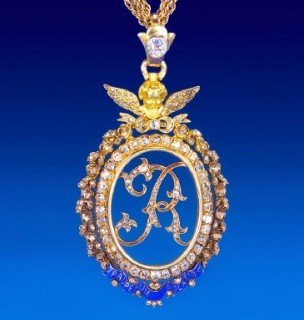Here are the links to the official website:
Real Ordem de Nossa Senhora da Conceição de Vila Viçosa
The Royal Order of Our Lady of Conception of Vila Viçosa is one of the three dynastic orders of the Portuguese Royal House. It was created by King D. João VI, on February 6th 1818 (on his acclamation, in Rio de Janeiro, Brazil). The purpose of the King was to honour Our Lady of Conception (who had been crowned Queen of Portugal and Patroness of the Kingdom, by King D. João IV, in 1646), after Portugal have remained as an independent country, after the Napoleonic invasions.
The Order was to be given as a military decoration for those who had served the King and prooved to be faithful to Our Lady and the Pope.
Initially, it was limited to 12 Grand Crosses, 40 commendations and 100 knights. The Grade of Grand Cross was normally given to the members of royal families and the title of Commander to the members of the nobility who held high positions within the Court.
The insignia of the Order is constituted by a blue band with a white stripe and a medallion in form of a star surmounted by the royal crown, with a circle in the middle, where one can read the following inscription:
"VM [Virgin Mary] / Patroness of the Kingdom". The emblem was designed by the renowned Court Painter Jean Baptise Debret, in 1818.
Real Ordem de Santa Isabel
The Royal Order of Saint Isabel has its patron saint on D.ª Isabel of Aragon (1270-1336), the wife of King D. Dinis.
It was established on November 4th 1801, by the Prince Regent D. João and its first Grand Mistress was Princess D.ª Carlota Joaquina (future queen consort), who awarded the decoration to many Portuguese, Spanish and Brazilian ladies, between 1801 and 1830.
It was first Portuguese Order exclusively female and its purpose was to distinguish 26 catholic ladies, for services to the Crown and welfare initiatives, praticed in the tradition of the Holy Queen.
The insignia of the order is made up of a pink band with a white stripe in the middle and a crowned medallion decorated with a frame of golden roses. In the middle of it there is an enamel portrait of Queen Saint Isabel of Portugal, giving goods to a poor man (an allusion to the famous Miracle of the Queen Saint), and the following Latin motto: "Pauperum Solatio".
The emblem was designed by Jean Baptiste Debret in 1818, when the Portuguese Court was still in Brazil.
Real Ordem de São Miguel da Ala
The Royal Order of St. Michael of the Wing was founded in 1147 by King D. Afonso I of Portugal, to honor a group of knights of the Order of St. James, who who have come to help taking Santarém from the Moors, on May 8th 1147.
Originally, its members belonged to the Military Order of St. James and that is why it still keeps the red sword and two fleur-de-lis (representing the Cistercian Rule).
King D. Miguel I, while in the exhile, recovered the order in 1848 and since then it has been granted as decoration by his descendants. It is destined to award people of any nationality and religion, in recognition to the extraordinary contributions to the Royal House or to the cult of St. Michael Archangel, traditionally revered as Angel of Portugal and Angel of Peace.






